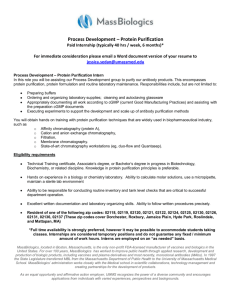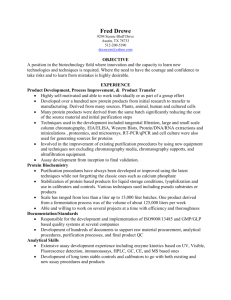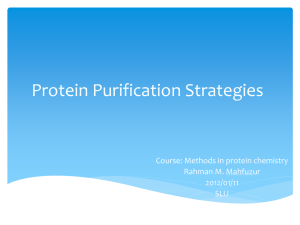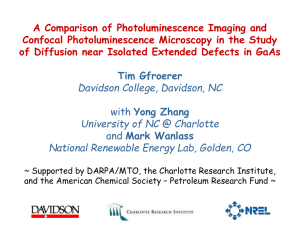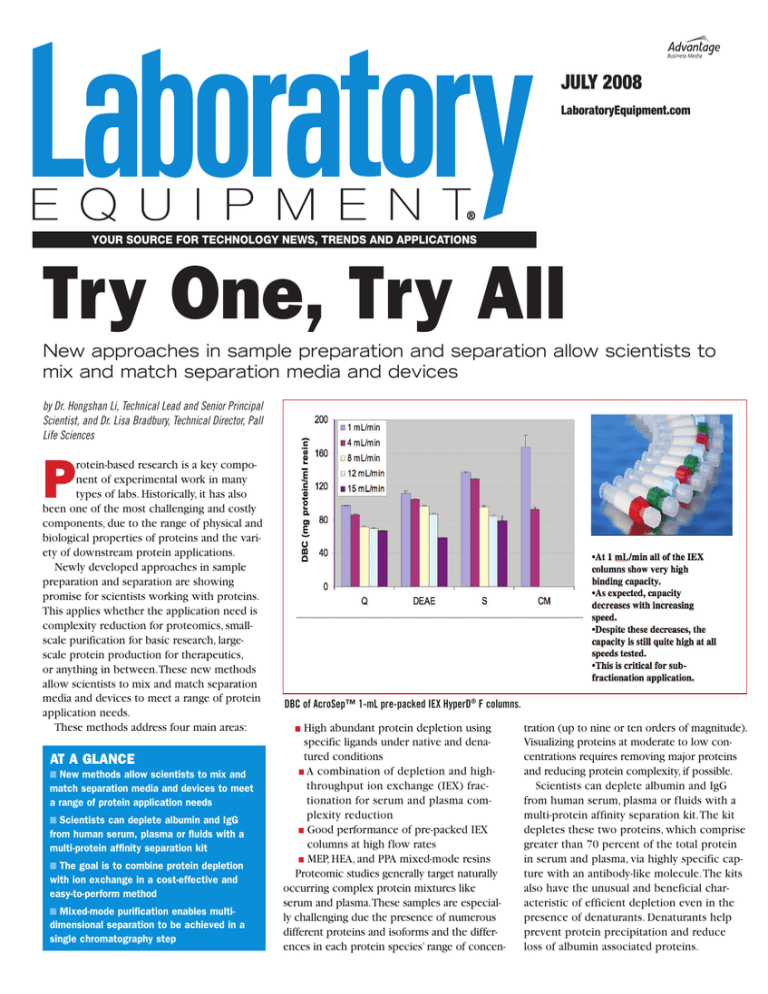
JULY 2008
LaboratoryEquipment.com
YOUR SOURCE FOR TECHNOLOGY NEWS, TRENDS AND APPLICATIONS
Try One, Try All
New approaches in sample preparation and separation allow scientists to
mix and match separation media and devices
by Dr. Hongshan Li, Technical Lead and Senior Principal
Scientist, and Dr. Lisa Bradbury, Technical Director, Pall
Life Sciences
P
rotein-based research is a key component of experimental work in many
types of labs. Historically, it has also
been one of the most challenging and costly
components, due to the range of physical and
biological properties of proteins and the variety of downstream protein applications.
Newly developed approaches in sample
preparation and separation are showing
promise for scientists working with proteins.
This applies whether the application need is
complexity reduction for proteomics, smallscale purification for basic research, largescale protein production for therapeutics,
or anything in between. These new methods
allow scientists to mix and match separation
media and devices to meet a range of protein
application needs.
These methods address four main areas:
AT A GLANCE
■ New methods allow scientists to mix and
match separation media and devices to meet
a range of protein application needs
■ Scientists can deplete albumin and IgG
from human serum, plasma or fluids with a
multi-protein affinity separation kit
■ The goal is to combine protein depletion
with ion exchange in a cost-effective and
easy-to-perform method
■ Mixed-mode purification enables multi-
dimensional separation to be achieved in a
single chromatography step
DBC of AcroSep™ 1-mL pre-packed IEX HyperD® F columns.
High abundant protein depletion using
specific ligands under native and denatured conditions
■ A combination of depletion and highthroughput ion exchange (IEX) fractionation for serum and plasma complexity reduction
■ Good performance of pre-packed IEX
columns at high flow rates
■ MEP, HEA, and PPA mixed-mode resins
Proteomic studies generally target naturally
occurring complex protein mixtures like
serum and plasma. These samples are especially challenging due the presence of numerous
different proteins and isoforms and the differences in each protein species’ range of concen■
tration (up to nine or ten orders of magnitude).
Visualizing proteins at moderate to low concentrations requires removing major proteins
and reducing protein complexity, if possible.
Scientists can deplete albumin and IgG
from human serum, plasma or fluids with a
multi-protein affinity separation kit. The kit
depletes these two proteins, which comprise
greater than 70 percent of the total protein
in serum and plasma, via highly specific capture with an antibody-like molecule. The kits
also have the unusual and beneficial characteristic of efficient depletion even in the
presence of denaturants. Denaturants help
prevent protein precipitation and reduce
loss of albumin associated proteins.
www.LaboratoryEquipment.com
Emerging
Technologies in
To further aid proteomics researchers with
protein complexity reduction, IEX resins such
as Q Ceramic HyperD are used in spin devices or well plates with native or denatured
abundant protein depletion kits. The result is
a rapid, reproducible and easy sample preparation method. These approaches can also be
used for very small-scale protein purification
or methods development work and are compatible with robotic systems.
The concept of combining depletion
with another kind of separation isn’t new.
The challenge is balancing the desire to see
deeply into the proteome with complexity
reduction methods while limiting possible
protein loss, the amount of time to process
each sample, and reagent cost. The goal
is to combine protein depletion with ion
exchange in a cost-effective and easy-toperform method.
High-speed chromatographic separations
require resins that combine the attributes
of a ceramic, rigid, non-compressible bead
“
Q HyperD F resolution at high speed.
Less time per run translates into greater overall productivity in the lab.
Other resins, such as MEP, HEA, and PPA,
are designed for more challenging protein
separations. They operate on a mixed-mode
mechanism, a combination of hydrophobic,
electrostatic and affinity (MEP only) properties of the chromatography ligands.
Using protein tools in combination presents a
new approach to protein sample preparation
and purification that can address challenging
separations.”
structure with a high-capacity hydrogel and
rapid interaction chemistry (i.e., IEX). This
combination results in superior performance,
particularly when used with 1-mL columns
that demonstrate high performance even at
speeds up to or above 15 mL/min.
Higher-speed chromatography runs allow
scientists to perform method development
and protein purification experiments more
rapidly, which is ideal because automated
chromatography systems are heavily used.
The beauty of mixed-mode purification
is the ability to achieve multi-dimensional
separation in a single chromatography step.
One mode can be emphasized during capture
(based on buffers) while another can be dominant during elution, and the scientist controls
these modes with their choice of buffers at
each stage.
All three resins provide unique selectivities
that can be exploited to achieve separations
that are impossible via traditional chroma-
tography resins, such as IEX or hydrophobic
interaction.
Additionally, MEP, HEA and PPA resins function under both physiologic and non-physiologic conditions, increasing compatibility
with upstream and downstream methods. The
resins are compatible with small spin devices,
manual and robotic-use multi-well plates, and
manually packed or pre-packed columns of
various sizes.
The challenge of protein separations is not
new. Fortunately the chromatography media
options (resin- and membrane-based) are constantly increasing, thus improving the likelihood that any purification will be successful.
Moreover, the choice of devices used with
these media has also increased, providing
scientists with additional method flexibility.
When the protein tools are used in combination, they present a whole new approach to
protein sample preparation and purification
that can address even the most challenging
separations. ■
For more information, contact Dr. Li at
hongshan_li@pall.com or Dr. Bradbury at
lisa_bradbury@pall.com.
Posted from Laboratory Equipment, July 2008. Copyright © Advantage Business Media. All rights reserved.
#1-24878530 Managed by The YGS Group, 717.399.1900. For more information visit www.theYGSgroup.com/reprints.
Pall Life Sciences • 600 South Wagner Road • Ann Arbor, MI 48103-9019 USA
Laboratory Technical Support • 1.800.521.1520 (toll-free in USA & Canada) • (+)800.PALL.LIFE (toll-free outside USA & Canada)
www.pall.com/lab • LabCustomerSupport@pall.com
AcroSep and HyperD are registered trademarks of Pall Corporation.


